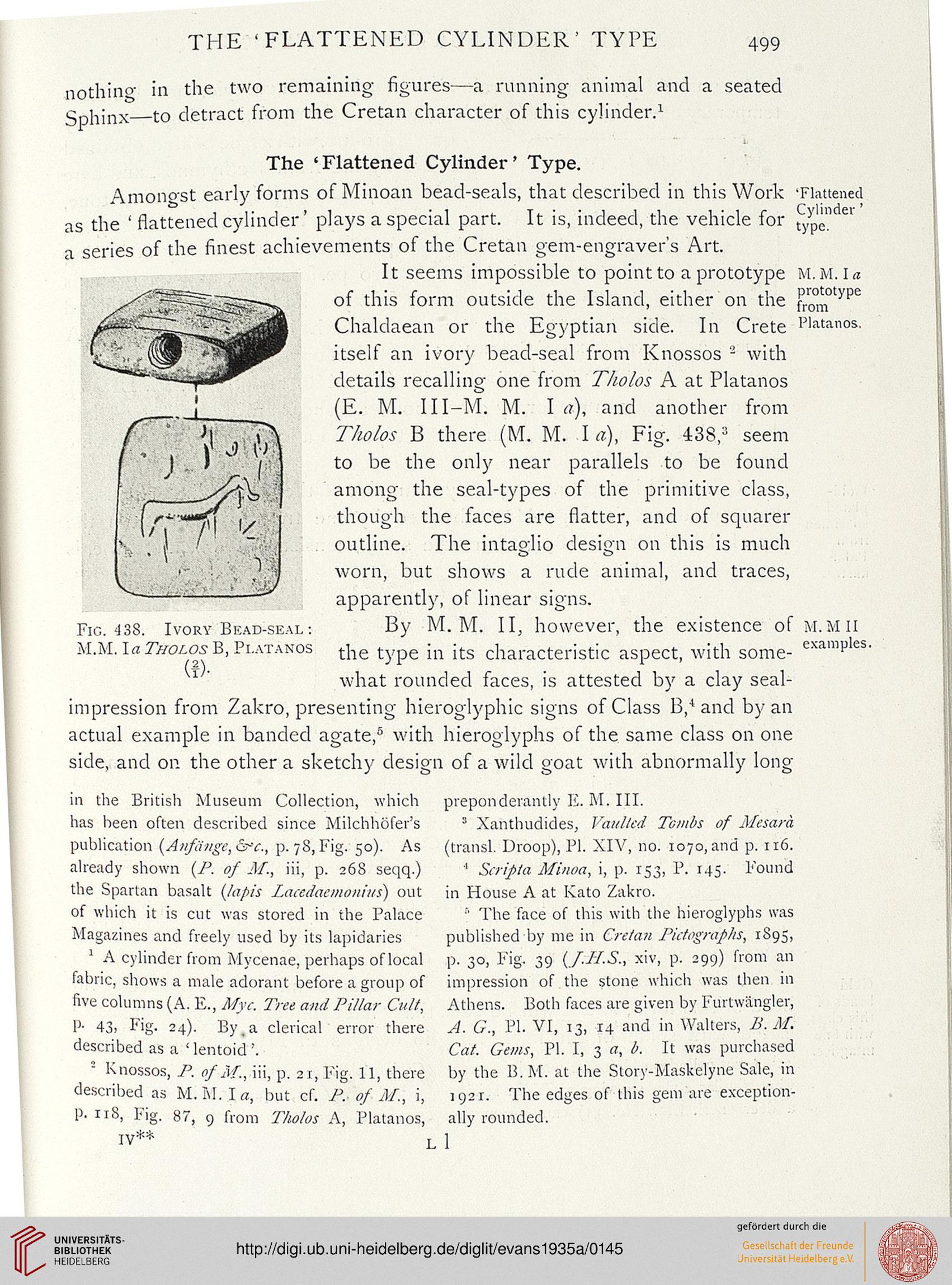THE 'FLATTENED CYLINDER' TYPE
499
nothing in the two remaining figure's—a running animal and a seated
Sphinx—to detract from the Cretan character of this cylinder.1
The ' Flattened Cylinder' Type.
Amono'st early forms of Minoan bead-seals, that described in this Work
as the ' flattened cylinder' plays a special part. It is, indeed, the vehicle for
a series of the finest achievements of the Cretan gem-engraver's Art.
It seems impossible to point to a prototype
of this form outside the Island, either on the
Chaldaean or the Egyptian side. In Crete
itself an ivory bead-seal from Knossos 2 with
details recalling one from T/io/os A at Platanos
(E. M. 11 DM. M. I a), and another from
Tholos B there (M. M. I a), Fig. 43S,3 seem
to be the only near parallels to be found
among the seal-types of the primitive class,
though the faces are flatter, and of squarer
outline. The intaglio design on this is much
worn, but shows a rude animal, and traces,
apparently, of linear signs.
By M. M. II, however, the existence of
the type in its characteristic aspect, with some-
what rounded faces, is attested by a clay seal-
impression from Zakro, presenting hieroglyphic signs of Class B,4and by an
actual example in banded agate,5 with hieroglyphs of the same class on one
side, and on the other a sketchy design of a wild goat with abnormally long
preponderantly E. M. III.
8 Xahthudides, Vaulted Tombs of Mesara
(transl. Droop), PI. XIV, no. 1070, and p. 116.
'' Serif ia Minoa, i, p. r53, P. 145. Found
in House A at Kato Zakro.
■'' The face of tins with the hieroglyphs was
published by me in Cretan Pictogrufks, 1S95,
p. 30, Fig. 39 (J.H.S., xiv, p. 299) from an
impression of the stone which was then in
Athens. Both faces are given by Furtwangler,
A. G., PI. VI, 13, r4 and in Walters, P.M.
Cat. Gems, PL I, 3 a, b. It was purchased
by the 15. M. at the Slory-Maskelyne Sale, in
i92r. The edges of this gem are exception-
ally rounded.
'Flattened
Cylinder '
type-
M. M. I a
prototype
from
Platanos.
Fig. 438. Ivory Bead-seal:
M.M. laTiroLOsB, Platanos
M.M II
examples.
in the British Museum Collection, which
has been often described since Milchhofer's
publication (Anfiinge, £W., p. 78, Fig. 50). As
already shown (P. of M., iii, p. 26S seqq.)
the Spartan basalt {lapis Lacedaemonius) out
of which it is cut was stored in the Palace
Magazines and freely used by its lapidaries
A cylinder from Mycenae, perhaps of local
fabric, shows a male adorant before a group of
five columns (A. E., Myc. Tree and Pillar Cult,
P- 43) Pig- 24). By. a clerical error there
described as a ' lentoid'.
" Knossos, P. of-M., iii, p. 21, Fig. 11, there
described as M. tit. la, but cf. P. of M., i,
P. 118, Fig. 87, 9 from Tholos A, Platanos,
IV** L 1
499
nothing in the two remaining figure's—a running animal and a seated
Sphinx—to detract from the Cretan character of this cylinder.1
The ' Flattened Cylinder' Type.
Amono'st early forms of Minoan bead-seals, that described in this Work
as the ' flattened cylinder' plays a special part. It is, indeed, the vehicle for
a series of the finest achievements of the Cretan gem-engraver's Art.
It seems impossible to point to a prototype
of this form outside the Island, either on the
Chaldaean or the Egyptian side. In Crete
itself an ivory bead-seal from Knossos 2 with
details recalling one from T/io/os A at Platanos
(E. M. 11 DM. M. I a), and another from
Tholos B there (M. M. I a), Fig. 43S,3 seem
to be the only near parallels to be found
among the seal-types of the primitive class,
though the faces are flatter, and of squarer
outline. The intaglio design on this is much
worn, but shows a rude animal, and traces,
apparently, of linear signs.
By M. M. II, however, the existence of
the type in its characteristic aspect, with some-
what rounded faces, is attested by a clay seal-
impression from Zakro, presenting hieroglyphic signs of Class B,4and by an
actual example in banded agate,5 with hieroglyphs of the same class on one
side, and on the other a sketchy design of a wild goat with abnormally long
preponderantly E. M. III.
8 Xahthudides, Vaulted Tombs of Mesara
(transl. Droop), PI. XIV, no. 1070, and p. 116.
'' Serif ia Minoa, i, p. r53, P. 145. Found
in House A at Kato Zakro.
■'' The face of tins with the hieroglyphs was
published by me in Cretan Pictogrufks, 1S95,
p. 30, Fig. 39 (J.H.S., xiv, p. 299) from an
impression of the stone which was then in
Athens. Both faces are given by Furtwangler,
A. G., PI. VI, 13, r4 and in Walters, P.M.
Cat. Gems, PL I, 3 a, b. It was purchased
by the 15. M. at the Slory-Maskelyne Sale, in
i92r. The edges of this gem are exception-
ally rounded.
'Flattened
Cylinder '
type-
M. M. I a
prototype
from
Platanos.
Fig. 438. Ivory Bead-seal:
M.M. laTiroLOsB, Platanos
M.M II
examples.
in the British Museum Collection, which
has been often described since Milchhofer's
publication (Anfiinge, £W., p. 78, Fig. 50). As
already shown (P. of M., iii, p. 26S seqq.)
the Spartan basalt {lapis Lacedaemonius) out
of which it is cut was stored in the Palace
Magazines and freely used by its lapidaries
A cylinder from Mycenae, perhaps of local
fabric, shows a male adorant before a group of
five columns (A. E., Myc. Tree and Pillar Cult,
P- 43) Pig- 24). By. a clerical error there
described as a ' lentoid'.
" Knossos, P. of-M., iii, p. 21, Fig. 11, there
described as M. tit. la, but cf. P. of M., i,
P. 118, Fig. 87, 9 from Tholos A, Platanos,
IV** L 1





